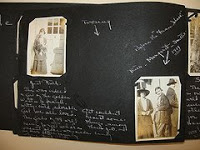On May 14, 1919, The Flat Hat (see page 3) reported on three "Easter Dances" held May 1st through 3rd in the dining hall. Examples of cards from other dances around this time period can be found at the SCRC's Flickr page. The article describes the dances, including the various hosting organizations, the band, and, apparently most importantly, who attended. Note that Easter fell on April 20th in 1919.
From similar college newspaper articles, it might be expected to include a list of women who went to the dances, including those from the College of William and Mary. However, this dance article only includes a lengthy list of the "visiting girls," or those women who came from off campus to the various dances.
I find it difficult to believe that none of the "Marys" attended the Easter dances. Some questions arise as to the neglect of the women college. Why are the college women not included in the listing? Is it possible the "Marys" did not attend any of the dances? Is it possible that the women held their own dances? Does the exclusion of the "Marys" signal any discord among the co-ed student body? These are just a few questions which prompt a deeper analysis of the reception of the women in addition to their adjustment to co-educational life.
This post was composed by Jordan Ecker.
For additional information about the first women students at the College of William and Mary see: When Mary Entered with her Brother William: Women at the College of William and Mary, 1918-1945 by Laura F. Parrish; "The Petticoat Invasion": Women at the College of William and Mary, 1918-1945; The Martha Barksdale Papers; and the Women at the College of William and Mary page on the Special Collections Research Center Wiki.
From similar college newspaper articles, it might be expected to include a list of women who went to the dances, including those from the College of William and Mary. However, this dance article only includes a lengthy list of the "visiting girls," or those women who came from off campus to the various dances.
I find it difficult to believe that none of the "Marys" attended the Easter dances. Some questions arise as to the neglect of the women college. Why are the college women not included in the listing? Is it possible the "Marys" did not attend any of the dances? Is it possible that the women held their own dances? Does the exclusion of the "Marys" signal any discord among the co-ed student body? These are just a few questions which prompt a deeper analysis of the reception of the women in addition to their adjustment to co-educational life.
This post was composed by Jordan Ecker.
For additional information about the first women students at the College of William and Mary see: When Mary Entered with her Brother William: Women at the College of William and Mary, 1918-1945 by Laura F. Parrish; "The Petticoat Invasion": Women at the College of William and Mary, 1918-1945; The Martha Barksdale Papers; and the Women at the College of William and Mary page on the Special Collections Research Center Wiki.




